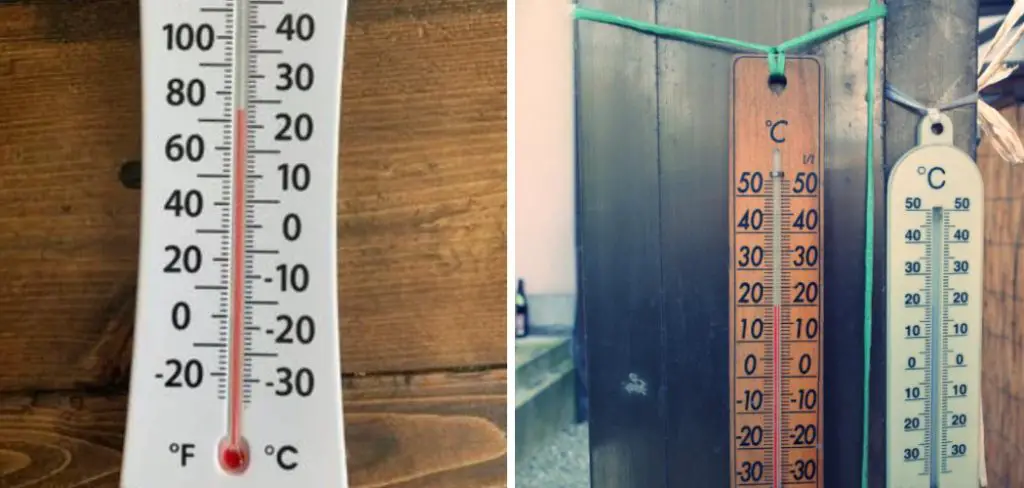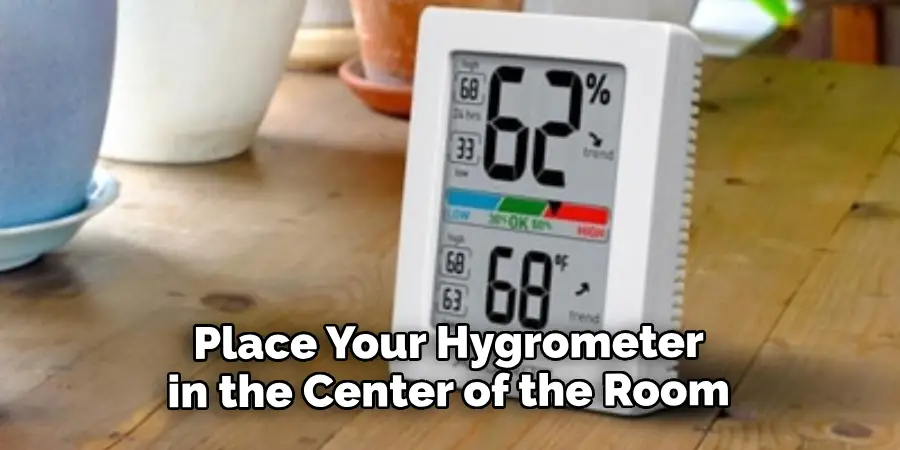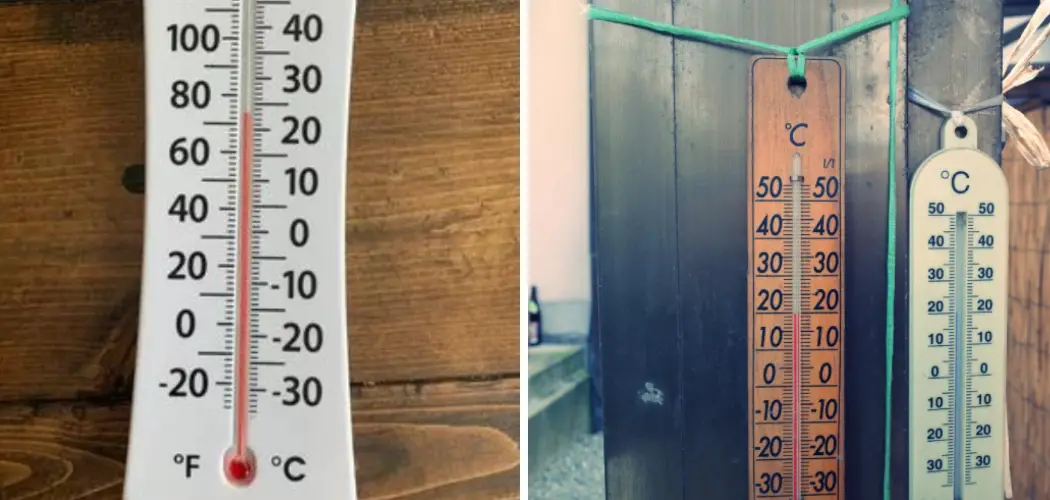Are you feeling a little stuffy and uncomfortable in your home? High humidity levels can cause big problems for the health of both your indoor environment and your family members. It’s essential to monitor your house’s humidity level; luckily, it doesn’t have to be difficult or expensive.

Knowing how to check the humidity level of a room can keep you safer from health hazards like mold growth while also improving your comfort. As the humidity level rises, so does moisture in the air – leading to musty smells, damaged walls and ceilings, and even respiratory issues.
In this blog post, we’ll cover everything you need to know about how to check humidity level in room so that you can assess if there is an excess amount of moisture present. Read on to learn more!
What Will You Need?
Before we dive into how to check the humidity level in the room, you first need to gather a few materials. Don’t worry, they aren’t anything fancy or expensive! Most of these items can be found already in your home.
- A Hygrometer: This is the main tool needed for measuring humidity levels. It’s a small electronic device found at most hardware stores or online.
- A Notebook and Pen: You’ll need to write down the humidity level readings for each room in your home so that a simple notebook will do.
- A Ladder or Step Stool: If you have high ceilings, you may need a way to reach the top of your walls where the humidity levels may be higher.
Now that you have all of your materials assembled, it’s time to start checking the humidity level in each room of your house.
10 Easy Steps on How to Check Humidity Level in Room
Step 1. Start with the Hygrometer:
Begin by turning on your hygrometer. You’ll need to give it a few minutes to adjust to the room’s environment before you get an accurate reading. This is a crucial first step in learning to check the humidity level in the room.
Step 2. Position the Hygrometer:
Place your hygrometer in the center of the room, away from any drafts or heat sources like vents, radiators, or electronics. These can skew the reading by affecting the air temperature in the immediate vicinity. Ensure it is also placed away from direct sunlight to avoid interference. Remember, you’re trying to measure the overall humidity of the room, so the placement should be as neutral as possible.

Step 3. Wait for the Reading:
After you’ve positioned the hygrometer correctly, patience is the key. Wait for about 15-20 minutes without significantly altering the room’s conditions (like opening a window or turning on an air conditioner). This period allows the hygrometer to gauge the room’s average humidity level accurately. After the waiting period, check the digital hygrometer. It should display a percentage – this is the room’s humidity level. Jot down this percentage in your notebook. Make sure to note the room’s name alongside the reading for future reference.
Step 4. Check Other Rooms:
After you’ve successfully taken a reading in one room, it’s time to move on to the next. Repeat the process for each room in your house – from the kitchen to the bathroom, living room, and bedrooms. Remember to place the hygrometer in a neutral location in each room and wait for about 15-20 minutes before taking the reading.
Remember to write each reading in your notebook, clearly labeled with the room’s name. Understanding the humidity levels throughout your home is crucial in maintaining a healthy and comfortable indoor environment.
Step 5. Analyze the Results:
Once you’ve checked the humidity level in every room, take some time to analyze the results. Use the humidity level chart for reference – 30-50% is considered the ideal indoor humidity level. If the humidity level in any room is above 50%, it means the room is too humid and may be prone to mold growth and other issues. If it’s below 30%, the room may be too dry, which can cause skin irritation and other discomforts. By comparing your readings to these standards, you can determine which rooms may need attention or adjustments.
Step 6. Take Action:
After analyzing the results, it’s time to take action. If a room’s humidity level is too high, consider using dehumidifiers or increasing ventilation to lower the moisture level. On the other hand, if a room is too dry, using a humidifier can help increase the humidity to a comfortable level. Regularly cleaning your home, especially areas prone to dampness like bathrooms and kitchens, can also help regulate humidity levels.

It’s important to revisit the process of checking humidity levels periodically to ensure that your corrective actions are effective. Remember, maintaining the right balance is key to your comfort and health.
Step 7. Regular Monitoring:
Monitoring your home’s humidity levels is essential to ensure a healthy and pleasant living environment. Repeat the process of checking humidity levels every few weeks or when you notice a significant change in the air quality. This could be when the season changes, after a major weather event, or if you’ve recently modified your home’s heating, ventilation, or air conditioning systems. Regular monitoring and quick adjustments can help prevent major high or low-humidity issues.
Step 8. Optimize Your Home Environment:
After the measurements and analysis, it’s time to optimize your home environment based on the findings. If your humidity levels are too low, consider adding moisture-absorbing houseplants or a quality humidifier. Alternatively, if the humidity is high, purchase a dehumidifier or make sure your home is adequately ventilated.
Another option could be utilizing moisture-absorbing products available in the market. These small changes can help create a more comfortable living space and prevent potential health risks or damage to your property due to improper humidity levels.
Step 9. Consult a Professional if Needed:
If you’ve taken all possible measures and still find the humidity level in your house to be outside the comfortable range, it may be time to seek professional help. Contact a local HVAC professional who can thoroughly inspect your home’s ventilation and heating systems to identify any issues or inefficiencies. They can suggest remedial measures or improvements to help regulate the humidity levels more effectively. It’s always better to be safe and ask for expert advice when needed.

Step 10. Be Proactive for Future Prevention:
Last but not least, it’s always better to proactively manage your home’s humidity levels. Regular maintenance checks of your HVAC system, addressing any leaks promptly, using exhaust fans in bathrooms and kitchens, and maintaining good indoor plants are some ways to prevent excessive moisture accumulation. Remember, a healthy home is a happy home. Stay vigilant and proactive in monitoring your home’s humidity levels, and you’ll be better equipped to handle any potential issues before they escalate.
By following these steps, you can effectively check the humidity level in every room of your house and take the necessary measures to maintain a healthy and comfortable indoor environment. Regular monitoring and quick action are key to ensuring ideal humidity levels for you and your loved ones.
5 Additional Tips and Tricks
- Use a Dehumidifier: If you live in a particularly humid area, investing in a dehumidifier can help maintain a comfortable humidity level in your home. Dehumidifiers pull excess moisture from the air, helping prevent mold and mildew growth.
- The Ice-Cold Glass Method: Fill a glass with ice water and wait a few minutes. The humidity is high if condensation forms on the outside of the glass.
- Look for Visible Signs: Regular condensation on windows, damp spots on walls, or a musty smell can all indicate high humidity.
- Consider the Health of Your Houseplants: Plants like ferns thrive in high humidity, while cacti prefer dry conditions. If certain plants are thriving or wilting, it could be due to the room’s humidity.
- Feel the Air: Although there are more accurate methods, sometimes you can get an idea of the humidity level simply by how the air feels. High humidity often makes a room feel ‘sticky,’ while low humidity can make the air feel dry to your skin and respiratory system.

With these tips in mind, you should now feel more confident about checking and monitoring the humidity level in your room. Remember to regularly check and adjust as needed for a comfortable and healthy living space.
5 Things You Should Avoid
- Neglecting Regular Checks: Avoid the mistake of not regularly checking your room’s humidity level. Sudden changes in temperature and humidity can significantly impact your comfort and health.
- Ignoring Humidity Signs: Never overlook signs of high or low humidity, such as excessive condensation, dry skin, or increased allergies. Take immediate action to rectify the situation.
- Over-Reliance on DIY Methods: While DIY methods can give you a general idea about humidity levels, they are only sometimes accurate. Do not solely rely on these methods; consider investing in a reliable hygrometer.
- Overuse of Humidifiers or Dehumidifiers: Using these devices excessively can lead to an overly humid or dry environment. It’s crucial to balance their use based on the current humidity condition of your room.
- Disregarding Room Factors: Various factors like room size, ventilation, and number of occupants can affect humidity levels. Avoid neglecting these factors when assessing and adjusting your room’s humidity.

By avoiding these common mistakes, you can effectively maintain a comfortable and healthy humidity level in your room.
Conclusion
Therefore, it is important to adhere to the best practices recommended in this blog post when checking the humidity level of your environment. Now that you are aware of how to check humidity level in room, it is time to put these tips into practice and make sure you are living in a comfortable and clean environment.
After all, air quality is one of the most essential elements for healthy living, so why not start today? Knowing more about indoor air will only allow us to make better decisions as we strive to maintain a safe and healthful environment for ourselves and our families. Get out those hygrometers and test the level! Taking steps towards improving air performance in your home is definitely within reach. Proper maintenance may be sometimes overlooked or set aside due to other busy priorities, but it doesn’t have to remain like that.
Begin taking action today and make sure that both yourself and others around you can enjoy fresh, healthy air regularly by investing some effort into occasionally monitoring humidity levels in your room.
About
Angela is the chief editor of Indoorense. She began her career as an interior designer before applying her strategic and creative passion to lifestyle and home.
She has close to 15 years of experience in creative writing and online content strategy for housekeeping and cleaning,home decorations as well as other efforts.
She loves her job and has the privilege of working with an extraordinary team. She lives with her husband, two sons, and daughter in Petersburg. When she’s not busy working she spent time with her family.

